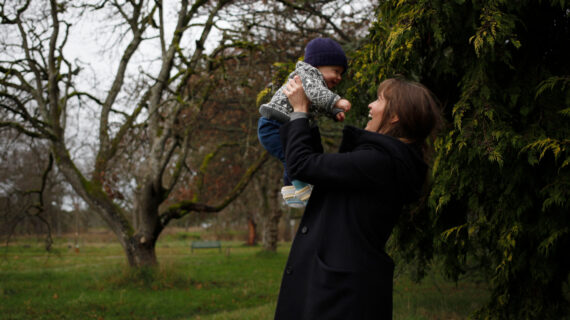In this Hub Dialogue, The Hub’s editor-at-large Sean Speer speaks to Shaylyn Romney Garrett, who is a writer and thinker dedicated to transforming our hyper-individualistic culture and building a new sense of community.
This conversation has been revised and edited for length and clarity.
Sean Speer
Today’s Hub Dialogue is with thinker, writer, and social entrepreneur Shaylyn Romney Garrett about her 2020 book, co-authored with famed social scientist Robert Putnam, entitled The Upswing: How America Came Together a Century Ago and How We Can Do It Again.
The Upswing is an extraordinary, multi-disciplinary book that combines economics, history, sociology, political science, and a practical understanding of community and civil society to describe big socio-cultural trends over the past century in America – namely, the shift from a “I” society to a “We” society, and back again.
Romney Garrett and Putnam unpack these major developments in order to better understand some of the challenges facing modern American society and to learn from these experiences to become a stronger, more unified country. It’s a must-read book with relevance for Canada’s own circumstances.
Shaylyn, thank you so much for joining us today.
Shaylyn Romney Garrett
My pleasure.
Sean Speer
You and Robert Putnam are an interesting intellectual partnership. You live in red America; he lives in blue America. You’re a woman; he’s a man. You have different kinds of training and you’re from different generations. I’ve heard Putnam say that you saw the same data and the broader cultural, economic, political and social trends that the data exhibited, and yet you used different lens to analyse and interpret them.
How did the two of you come to work together? And what does it say about the benefits of such an intellectual partnership?
Shaylyn Romney Garrett
Great question. Putnam and I have been working together in various different capacities for over 20 years now. I originally met him as a student at Harvard. I took a sophomore seminar course that he taught, the same year that Bowling Alone came out.
As many of your readers may know, Putnam’s most famous book, Bowling Alone, documents the decline in social capital, which is a way of describing community connectedness, relationships, and associations, all of those things being in sharp decline over the past half century or so. That book made quite a splash and actually spawned an entire field of research in social capital. I was lucky enough to be there at the beginning. As part of that course, I ended up writing about the Progressive era as an example of a time in America when there was a great boom in social capital building. I then went on to write an undergraduate thesis about the Progressive era, and then Putnam and I collaborated a number of different ways. Since then, he and I wrote a book together with Dave Campbell called American Grace: How Religion Divides and Unites Us, which is all about the role of religion in American civil society. We did that about 10 years ago, and we’ve always stayed in touch as good friends.
I remember a few years ago, having dinner with him and his wife, and Putnam told me that he had begun tinkering with some obscure data sets and noticing some pretty breathtaking correlations between them even though they covered very different sectors of American society. He thought that the trends he was seeing were pretty surprising.
And at the time, his book agent called this interesting research “five graphs in search of a story.” At some point along the line, Putnam suggested that he bring me in to collaborate again because I’m more of a storyteller. I was able to come in and really help craft a narrative that was both historical and contemporary, that spoke to the data, but also to how the data relates to what America is going through right now.
Putnam taught me everything I know about data analysis. He, of course, is a world class data scientist. I am not. But we make a great pair in that sense because we take very different views, and I do think the different generational take was very important. Bob lived through the upswing, and I’ve only lived through the downturn. Therefore, we have very different views about America.
Sean Speer
Well, let’s get into that narrative. The two of you describe what those graphs convey as a “I-WE-I” century. What does that mean, and why is it important?
Shaylyn Romney Garrett
I don’t think that it’s much of a surprise for people to hear that America could be described today as being a very “I” focused moment – a time when the focus is on “me.” It’s clear in the data that we are living in a time that is deeply economically unequal, deeply politically polarized, socially very isolated and disconnected, and in cultural terms, pretty narcissistic. Those are not just off-handed claims. Those are very measurable phenomena. We are deeper in those holes than we’ve been in a very long time, perhaps ever in our nation’s history. So, it’s not a surprise that now you could describe as an “I” moment.
But the question is, how did we get into this mess? That’s the driving question of The Upswing. In order to answer that question, Putnam wanted to zoom out and look not just at the last half century of American history which has of course been a period during when these negative trends have emerged. There’s been a lot of books written about what went wrong since the 1960s, which was, by many accounts, a sort of golden age in American history, particularly when it comes to something like social capital. But more than that for us was the question of what had gone on through the entire century along these various dimensions.
What we found was that, if we turn the clock all the way back to the beginning of the 20th century, America looked remarkably similar to what it looks like today. We had another “I” moment roughly 120-125 years ago, and in between, we had a move distinctly out of that “I” moment during the Gilded Age at the beginning of the 20th century. Over the course of the other two-thirds of the 20th century, we moved steadily according to scores of different measures (including culture, economics, politics, and society) into the direction of greater solidarity, and a greater “WE” focus. We moved this more “WE” direction until we hit a peak or a turning point at the mid 1960s, in which everything turned back downward, and landed us back in the mess that we’re in today. That’s how we come to the description of the 20th century being America’s “I-WE-I” century.
Sean Speer
You tell the story of the upswing in the early to mid 20th century by conveying the cultural, economic, political and social factors that contributed to this renewed sense of community and broader social wellbeing. Are you able to discern what the leading variable was? How should we think about the causal relationship between these different forces?
Shaylyn Romney Garrett
That’s a great question, because it brings us back to the point that this is a very data driven book. This is not just a book where we were looking at the historical record. We were actually looking at very measurable phenomena. And if you’re looking at the data, you’re exactly right to say that statisticians will often ask the question, “what was the leading variable?” If you’re looking at trends that all turn to the similar direction at the same time, which is what we see with all these different data points here, then you might wonder which one turned first because if you knew which one turned in the right direction first, it might give you some sort of silver bullet to focus on to get that upward movement going again.
From the data, we do know what was not the leading variable, which turns out to be kind of a surprise. It turns out that economics is not the leading variable. Oftentimes, in social science, we have this view that culture, morals, and social connections are sort of the froth on the waves of history, and what actually drives change is economics. But in this case, it seems quite clear that economics – namely, a movement toward greater economic equality – came last, not first, during this period of the first two thirds of the 20th century.
Instead it looks like what happened first was actually culture change. It looks like we, as a society, had a noticeable moral awakening, where we began to change our view of ourselves as citizens and our responsibilities rather than just our rights. Then a lot of different decisions, including political, social, and otherwise, flowed from that re-evaluation of our values. That’s a really surprising lesson and important lesson for today. Because I think today, when we think about how to get out of this mess in America, we focus on the right political maneuvering or the right social programs, or where do we invest our federal dollars. But I wonder if there are questions are actually second-order questions and instead we need to get questions about morality and culture in order first before we’re going to see measurable change. That certainly was the case back at the beginning of the 20th century.
Sean Speer
If cultural renewal is indeed the leading variable, what role can we play individually or collectively to catalyze a modern cultural renewal? Is secularization in the modern age an obstacle to such renewal given that so many of the organizations in the Progressive era were guided by a religious ethic?
Shaylyn Romney Garrett
So, to your first question about what we can do as individuals in the face of this problem, let’s just be clear to define the problem. The problem is that we are existing currently in a hyper-individualistic moment in which our values have gotten a little bit out of whack, where we’re putting the individual above the collective. Now, that’s not to say that the collective should be above the individual. But the goal, at least in American society, has been to achieve a balance between individual liberties and the collective project that we’re engaged in.
Right now, our society is focused on the individual extreme of our culture. In the Progressive era, what happened was that we actually had a number of wealthy, elite people who had benefited from a society that was lopsided, experience moral moments where they really saw clearly the effect that that was being had on the people at the bottom. What’s interesting is that in those moments, there’s a couple different ways that we can react. One is to have moral indignation and moral outrage directed outward at the “bad apples” of society. If we could just get rid of that, if we could cancel that, everything would be fine. But actually, in the Progressive era, what happened was what historian Richard Hofstadter called moral indignation directed inward. So, you suddenly have these elites who began to realize that they had created the problem – that they were part of the problem – and began to actively work to change the systems from which they had benefited.
And so, today, we can point to the elites and say, “we need them to do that.” But I think all of us can do that too. We can all look inward and say, “in what ways am I fostering a hyper-individualistic culture in this country? How can I, starting right where I am in my community, begin to connect with those around me and begin to foster more of a “WE?”” Asking that question is actually the beginning of it all.
I think to your point about religion, a bit of this moral indignation that happened in the Progressive era was actually a questioning of Christianity itself. Many of the thinkers at the time were actually calling Christianity to account for not being true to its own values. It wasn’t like Christianity came in and saved everything, or religion came in and reminded everyone to be moral. What happened was a very careful re-thinking of the role that religion was playing in society and calling for Christianity specifically to be truer to its core values of being “My Brother’s Keeper” or the “Golden Rule” and these things that are so familiar to us, but somehow got lost when we translate that religious morality into the public sphere.
Today I look to thinkers like the Reverend William Barber, who is leading moral marches on Washington and trying to revive Martin Luther King Jr.’s Poor People’s campaign, asking us to think as Christians or as religious people in general, “how do our religious values inform what we do in the public square?” If we’re not asking that question, we’re not being morally reflective, and I think that that’s important work.
Sean Speer
Just one final question. You said when one of the challenges in some of the issues you describe is that the “I” trends aren’t all fundamentally bad: the rise of individualism and personal expression were important counterweights to conformity, misogyny, racism, and so on. There are a lot of people who say that these gains, especially for vulnerable and marginalized voices, may be worth the decline in social capital. Is there a middle ground? Is the right future some sort of “I-WE” synthesis?
Shaylyn Romney Garrett
Absolutely. In fact, when you look at that 1960s turning point, any historian of the 1960s basically describes the decade as occurring in two halves. The first half was the Kumbaya, communes, hippie, “all you need is love” trend. And then all of a sudden, the second half of the 1960s was what I think the historian Todd Gitlin called “days of rage.” He coined the phrase “years of hope, days of rage,” to describe that split.
What was really happening in those supposedly “years of hope,” under the surface, were a lot of cultural critics saying, “We’ve gone too far in the direction of conformity and community, we need a little more individual rights here and a little more self determination.” So, what happened in the 1960s and 1970s, both culturally and politically, was a real emphasis on individual rights and liberties, which opened up American society to people that had been excluded and led to a lot more diversity. These were great developments for people of colour, women and other communities. However, the problem is that we swung too far in that direction of a hyper-focus on individual rights.
We can look at America’s founding ideals, not to say that we were ever perfect in implementing them. But I hark back to Alexis de Tocqueville, who visited the United States in the 1830s. When he came here, he was really surprised by how much communitarianism he saw in the United States. And yet, what we often forget about Tocqueville is that he also coined the term individualism to describe what he saw in America at the time, and he struggled with how to reconcile that America was both deeply individualistic – deeply committed to liberty – but also really remarkably able to band together to accomplish common goals and to associate and to engage in mutual aid. He coined a phrase that was a concept that helped him understand the balance, and that phrase is “self interest rightly understood.”
What he meant by that was the fact that Americans grasp the idea of “what’s good for all turns out to be good for me. So, in the long run, what’s in my interest is actually creating a society that’s good for everyone.” I think that’s something we’ve forgotten. Sometimes we think that community and individualism are inherently in competition; that they’re diametrically opposed, and you can have either one or the other. I don’t think that’s right.
I think that Putnam and I in this book really wanted to emphasize that the solution to hyper-individualism is not hyper-communitarianism, but that we need rather to get back into balance in terms of these twin American values that have gotten a little bit out of whack. And I think that balance is absolutely possible. I don’t think that we’ve achieved that balance truly, even though in the 1960s we probably by hard measures came closer to that ideal than ever before. Still American society was too exclusionary in different ways.
So today, any upswing that we would hope to engage in again, has to be absolutely and fully inclusive. But it also has to be something that motivates us to sometimes put responsibility over right and to put the interests of the whole over the interests of the one. When we see the challenge that America has faced with the pandemic, it ought to serve as a real object lesson in what happens when we lose sight of that “self interest rightly understood.” I hope that our cultural commentators will begin to call us to account and remind us of what’s been lost during this last 50 to 70 years, as we’ve slid into the hyper- individualism that we see today.
Sean Speer
Well, the book is The Upswing: How America Came Together a Century Ago and How We Can Do It Again.
Thank you so much for joining us, Shaylyn, to talk about the book and its powerful insights. These ideas are not only relevant for an American audience, but they extend to our own society here in Canada and other societies around the world.
Shaylyn Romney Garrett
Thank you. It’s been fun.




